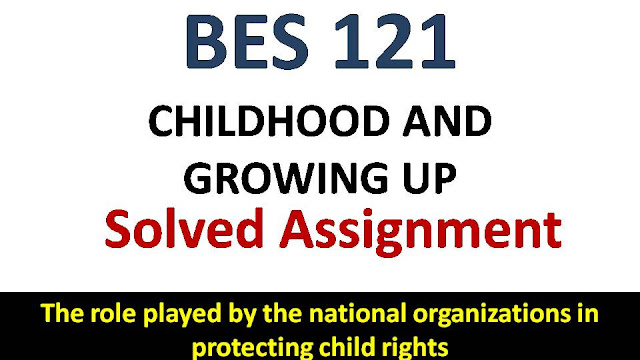The role played by the
national organizations in protecting child rights
Introduction
1. This report is submitted to the Human Rights Council
pursuant to resolution 16/12 of 24 March 2011, during which it invited the
Office of the diplomat for Human Rights (OHCHR) to conduct a study on challenges,
lessons learned and best practices during a holistic, child rights and
genderbased approach to guard and promote the rights of youngsters working
and/or living on the road and to present it to the Council at its nineteenth
session. the role played by the national organizations in protecting child
rights, Analyze the role played by the national organizations in protecting
child rights. Discuss the areas in which more attention is needed for the
implementation of child rights, It also requested OHCHR to conduct the study in
close collaboration with relevant stakeholders, including States, the United
Nations Children’s Fund (UNICEF) and other United Nations bodies and agencies,
the Special Representative of the Secretary-General on violence against
children, the Special Representative of the Secretary-General for youngsters
and armed conflict, the Special Rapporteur on the sale of youngsters , child
prostitution and kiddie porn and other relevant special procedures mandate
holders, regional organizations, civil society, national human rights
institutions also as children themselves.
2. Contributions were received from States, intergovernmental
organizations, national human rights institutions, non-governmental
organizations (NGOs), academia and individual experts. On 1 and a couple of
November 2011, OHCHR, with the support of Aviva,1 the Consortium for Street
Children and UNICEF, organized an expert consultation on children working
and/or living on the road , to collect input from different stakeholders. Analyze
the role played by the national organizations in protecting child rights.
Discuss the areas in which more attention is needed for the implementation of
child rights, Two documents were commissioned by OHCHR for this process: a
worldwide research paper by independent consultant, Dr. Sarah Thomas de
Benitez; and a paper on the views of youngsters led by the Consortium for
Street Children. Both documents, also because the results of the consultation,
written submissions, input from States and other stakeholders informed the
preparation of this report.
II. International legal standards
3. The international legal framework establishing the
obligations of States in reference to children has never been as comprehensive
because it is today. The 1989 Convention on the Rights of the kid constitutes
the most international instrument for the promotion and protection of the
rights of the kid , and it applies to all or any children altogether
circumstances. Its almost universal ratification demonstrates the importance
that States accord to the protection and promotion of the rights of youngsters
. Analyze the role played by the national organizations in protecting child
rights. Discuss the areas in which more attention is needed for the
implementation of child rights, The Convention is exclusive because the first
legally binding instrument to require a holistic approach to the rights of the
kid . the role played by the national organizations in protecting child rights It
covers an entire range of rights – civil, political, economic, social and
cultural; establishes a framework of duties for various actors; marks a
milestone in recognizing all children as rights holders and reaffirms the
overall principles of best interests of the kid , non-discrimination,
participation, survival and development because the framework for all actions
concerning children.
4. All children, regardless of their economic status, race,
colour, sex, language, religion, national, ethnic or social origin, property,
disability, birth or the other status have an equivalent rights and are
entitled to an equivalent protection by the State. While the Convention makes
no particular regard to children working and/or living on the road , all its
provisions are applicable to them.
5. The Committee on the Rights of the kid , the body of
experts responsible of monitoring the implementation of the Convention,
regularly raises the difficulty of youngsters in street situations in its
dialogue with State parties, and refers specifically to their situation in
several of its general comments, especially No. 13 (2011) on the proper of the
kid to freedom from all sorts of violence, No. 12 (2009) on the proper of the kid
to be heard and No. 10 (2007) on children’s rights in juvenile justice. Other
treaty bodies have also mentioned things of youngsters , both boys and girls,
living and dealing within the street, and have made recommendations during this
regard.
6. additionally to the Convention, its Optional Protocols on the sale of youngsters , child prostitution and kiddie porn and on the involvement of youngsters in armed conflict and therefore the recently adopted Optional Protocol on a communications procedure, it must be noted that each one core human rights treaties apply to both adults and children; indeed, some contain specific provisions concerning children, like article 7 of the Convention on the Rights of Persons with Disabilities. the role played by the national organizations in protecting child rights Analyze the role played by the national organizations in protecting child rights. Discuss the areas in which more attention is needed for the implementation of child rights, Other international instruments are also key to the protection of youngsters working and/or living on the road , particularly those handling child labour, trafficking, juvenile justice and alternative look after children. the role played by the national organizations in protecting child rights These include the Minimum Age Convention No. 138 (1973) and Worst sorts of Child Labour Convention No. 182 (1999) of the International Labour Office, which distinguish between acceptable work administered by children and economic exploitation, or child labour, of which total abolition should be achieved.







0 comments:
Note: Only a member of this blog may post a comment.